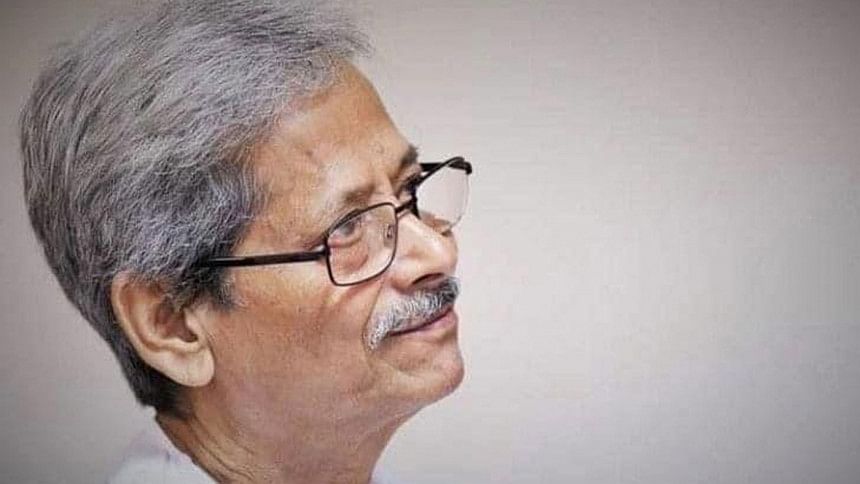Kashinath Roy: A teacher, poet and mentor of extraordinary stature

My teacher Professor Kashinath Roy (1947—2021)—poet, short story writer, essayist—died on January 17, at 74. Or did he die?
Professor Roy was my direct teacher in the Department of English, Dhaka University (DU), where I studied as an undergraduate. I recall the moment when I first saw him: he immediately stood out from the crowd because of his attire and appearance. Indeed, his immaculate white pyjama and panjaabi remained constant in his life—attire that also seemed organic to his body and his being—making the point that style itself is political.
Professor Roy taught us the English novelist and poet Thomas Hardy. He had a style of language and a cadence of his own, which stole into the heart with strange and remarkable power. He used to pace back and forth in our classroom, generating a spatial rhythm that we thought harmonised with the temporal movements of his beautifully textured sentences that also exemplified verbal economy. For him teaching was a work of art.
Kashinath Roy's lectures on Hardy's Egdon Heath and novelistic architectonics, on Greek and Shakespearean tragedies, and on Jane Austen's persistent preoccupations with money and manners and morals and marriage in her work have still remained with me. I am inclined to characterise his pedagogy as poetic and performative—a pedagogy that shows how teaching itself is love made visible.
We—his students—continued to marvel at the depth and range of his knowledge. He taught us the poetics and politics and philosophy of the novel, while also demonstrating that the novel is a world unto itself and yet imbricated in the world outside it. He was characteristically and critically attentive to that very dialectic of the word and the world. While he passionately valorised the aesthetic dimensions of literary works, he never sealed them off from the historical, the social, and the political as such. For him "close readings" were never closed readings.
In short, Professor Roy was a committed, brilliant, articulate, engaged, and even a very popular teacher—one whose life seemed to depend on teaching. I was exceedingly fortunate that I quickly became close to Professor Roy. I even frequented his residence at one point. Thus, we had numerous informal conversations that ranged within a broad zodiac of our concerns while involving and intensifying my three abiding passions in life—poetry, politics, and philosophy.
Indeed, it was Professor Roy who got me interested in the great French symbolist poet Stéphane Mallarmé and the Austrian-British philosopher Ludwig Wittgenstein, while he did much to deepen my interest in Shakespeare. I was then bedazzled by his knowledge of Shakespeare. As the story has it, before he came to study English at DU, he had memorised Shakespeare's Hamlet in its entirety. I myself repeatedly saw how my teacher could quote Shakespeare at the drop of a hat while offering lucid interpretations of his plays and relating them to the dull prose of our daily living, thereby making Shakespeare come alive.
Our conversations also surrounded Marxian political economy at one point. I found Professor Roy decisively anti-capitalist and anti-colonial in his orientation and sensibility while I clearly sensed his strong predilection for socialism in the face of monstrous anti-socialist aestheticism, aggressively prevalent as it was in his milieu. It is not for nothing that he held his teacher (and my teacher) Serajul Islam Choudhury—the country's leading socialist intellectual—in high esteem.
To many of us, indeed, Professor Roy was one of the best teachers of Bengali literature as well, and one of the best contemporary Bengali poets, one whose beautiful and powerful lines I tirelessly exchanged and discussed with my great peer and senior poet-friend Golam Faruque Khan. Although this is not the place to evaluate Kashinath Roy's prose and poetry—I've plans to do so in the future of course—I still intend to touch quickly on what he himself called his "transactions with words."
In 2009 Kaiser Haq—Kashinath Roy's longtime close friend and my teacher—provided a brief but useful note on his work: "Kashinath Roy began writing in his teens, and in the sixties published regularly in periodicals like Kanthwaswar [….] After that he published little, though he kept on writing—poems, short stories, at least one novella. […] He was 60 when he published his first book, a verse play [called Divine Comedy] he had written in his teens. And, at 61, he published a substantial collection of […] poems, Jibanananda Dekhun ("Take a Look, Jibanananda")." Haq added: "These poems are forthright, often bitterly satirical, eminently readable, and a most pertinent commentary on the state of our nation." Then, in 2012, his third and last book—again a collection of poems—called Ami Jaha Dite Pari came out. In other words, Kashinath Roy published a total of three books during his lifetime.
Kashinath Roy also wrote several short stories. His "Rupantar" (1964) and his "Memsaheber Paa" (1977) in particular are both disruptive and innovative works that at once attest to his distinctive fictional imagination and matchless prose, although those works have not received critical attention at all. Further, he wrote a number of essays and articles in both English and Bengali. Owing to space-constraints, I will mention only two—his long epistolary piece written in English under the nom de plume of Irfan Pramanik for the first-rate magazine of the arts called Form (edited by my teacher Professor Shawkat Hussain) and his late autobiographical meditation in Bengali called "Nibhrito Shikkhoker Sandhane" that appeared in the journal Natun Diganta (edited by Professor Serajul Islam Choudhury). His autobiographical piece also fiercely mobilises a devastating critique of our market-driven academic culture, our colonial mindset, and our middle-class hypocrisies, among other things. But Kashinath Roy is a poet in the first place—a powerful and distinctive one at that (to say the least)—one who has hitherto been seriously neglected in Bangladesh.
On more personal registers: When I was 19 and in my second year in the English department, out of my profound admiration for my teacher's work, I ended up translating one of his representative poems into English. And my teacher Professor Shawkat Hussain generously published it in his magazine Form. But when I saw my translation in print, it suddenly occurred to me that I could not do justice to Kashinath Roy's original poem. I made it a point not to face my teacher immediately. Yet I bumped into him while he immediately but ardently thanked me for that translation. Such was his magnanimity!
Indeed, what kind of a person was my teacher Kashinath Roy? In his autobiographical meditation, he declares: "There is no doubt that I'm an oddball in this society." Yes, my teacher was exemplarily "weird," remarkably "strange," exceptional. Never did he care about worldly success, nor did he "network" in an environment where networking is deemed both practical and profitable, nor did he ever seek any form of what the French sociologist Pierre Bourdieu calls "cultural capital" or "symbolic capital." No prominent critic ever cared to write in a sustained manner about whatever "little" my teacher had produced. But his life itself—lived as it was—embodied "rage against the machine" on the one hand and radical quietude on the other.
Is my teacher Kashinath Roy dead? My answer is "no." He remains—and will continue to remain—alive in our stories and our memories, in his invaluable contributions to his students' lives, and in his own works and words.
Azfar Hussain teaches in the Integrative, Religious, and Intercultural Studies Department within the Brooks College of Interdisciplinary Studies, Grand Valley State University in Michigan, and is Vice-President of the Global Center for Advanced Studies, New York, USA.

 For all latest news, follow The Daily Star's Google News channel.
For all latest news, follow The Daily Star's Google News channel. 



Comments